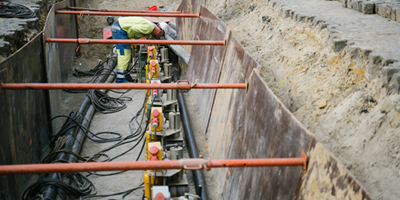Laying of underground high-voltage cables begins between Merelbeke-Melle and Wetteren
On 30 September 2025, we will start laying 36-kV high-voltage cables between the Kwatrecht (Oude Heirbaan in Merelbeke-Melle) and Wetteren (Kapellendries) high-voltage substations. This work will ensure security of supply in the future.
We lay underground high-voltage cables to carry electricity. There are currently still a number of outdated 36-kV cables running between the Sint-Amandsberg, Flora and Kwatrecht (Merelbeke-Melle) high-voltage substations. At the same time, we anticipate an increase in electricity consumption in the region to the east of Ghent. Our Ghent East (Gent-Oost) project therefore aims to prepare this area (Sint-Amandsberg, Merelbeke-Melle, Wetteren) for the future. The project involves upgrading outdated high-voltage cables between Sint-Amandsberg and Merelbeke-Melle, laying new underground cables between Kwatrecht and Wetteren, and upgrading several high-voltage substations.
The work is split into projects. The first cable project kicked off in May 2025 with the replacement of the underground high-voltage cables between Flora (Merelbeke-Melle) and Saman (Sint-Amandsberg). This work is running to schedule. The second cable project will get under way on 1 September, when we start laying the underground high-voltage cables between Kwatrecht (Oude Heirbaan) and Wetteren (Kapellendries). Work will begin that day with directional drilling in Kwatrechtsteenweg and then proceed in phases (for a more detailed timetable, see the chart below ). All underground cables between Kwatrecht and Wetteren are due to be in place by the summer of 2026. The final phase (starting in spring 2026) will involve upgrading the cables between Flora and Kwatrecht.
Limited disruption to traffic
An underground connection is usually laid using the open-trench method. We start by digging a trench between 600 and 1,000 metres in length, and then keep this trench section open until the cable has been laid in it. By working in sections, we minimise any disruption and impact from the work. The road is then restored to its original condition.



